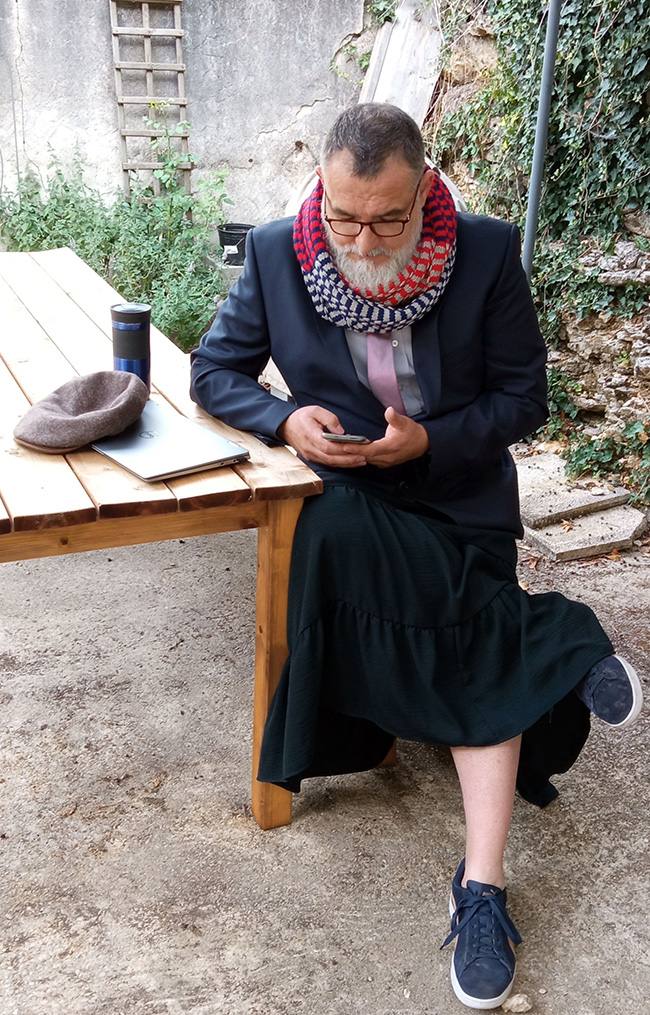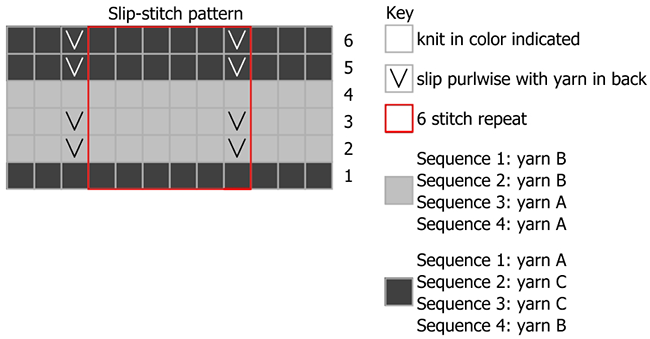Morley, a free knitting pattern from Knitty.com.
INTRODUCTION
Morley
 by Karen Fournier
by Karen Fournier
![]()
![]()
My inspiration for Morley were my university students who all wore big snuggly cowls even in the classroom. They always looked so elegant and hip no matter what they wore with them. I just had to have one! Morley has a simple slipped stitch pattern that is easily memorized so it makes for the perfect project for knitting in front of your favorite series or to bring to a chatty get together with your fiber group. It has a tubular shape so there is no ugly backside and is knit in the round. It also calls for a provisional cast on and grafting the ends together for a seamless join.
See pattern notes for working with a standard cast-on and bind off.
 model: S. Fournier
model: S. Fournier
 photos: Karen Fournier
photos: Karen Fournier
SIZE
One
FINISHED MEASUREMENTS
Width: 8 inches/20 cm
Length: 32 inches/81 cm (can be adjusted)
MATERIALS
Yarn
![]() [A] Drops Merino Extra Fine DK weight [100% merino; 115 yd/105 m per 50g skein]; color: Light grey; 3 skeins
[A] Drops Merino Extra Fine DK weight [100% merino; 115 yd/105 m per 50g skein]; color: Light grey; 3 skeins
![]() [B] Monoprix Super Doux DK weight [60% acrylic, 40% merino; 137 yd/125 m per 50g skein]; color: Burnt orange; 3 skeins
[B] Monoprix Super Doux DK weight [60% acrylic, 40% merino; 137 yd/125 m per 50g skein]; color: Burnt orange; 3 skeins
![]() [C] Drops Merino Extra Fine DK weight [100% merino; 115 yd/105 m per 50g skein]; color: Navy blue; 3 skeins
[C] Drops Merino Extra Fine DK weight [100% merino; 115 yd/105 m per 50g skein]; color: Navy blue; 3 skeins
Yarn Characteristics
![]() This pattern looks best in solid-colored or heathered yarns with a high contrast; smoother yarns work better.
This pattern looks best in solid-colored or heathered yarns with a high contrast; smoother yarns work better.
Recommended needle size
[always use a needle size that gives you the gauge listed below - every knitter's gauge is unique]
![]() US #6/4mm 16 inch/40 cm circular needle
US #6/4mm 16 inch/40 cm circular needle
![]() A second circular needle in the same size or smaller, for joining
A second circular needle in the same size or smaller, for joining
Notions
![]() 1 stitch marker
1 stitch marker
![]() 2 removable stitch markers
2 removable stitch markers
![]() yarn needle
yarn needle
![]() 1 yd/1 m waste yarn and crochet hook for provisional cast on
1 yd/1 m waste yarn and crochet hook for provisional cast on
GAUGE
24 stitches/28 rounds = 4 inches/10 cm in single color stockinette stitch.
It is not crucial to match gauge for this project, but note that working at a different gauge will result in a different size piece, and will affect yardage used.
PATTERN NOTES
[Knitty's list of standard abbreviations and techniques can be found here.]
Other than when stated in the pattern, there is no need to break the yarn between stripes.
Tangy VS Piquant: The pattern as written calls for a provisional cast-on and a grafted join, which puts it at the Piquant level. If you prefer something that requires less concentration, use the following techniques to make this a simpler Tangy knit: cast on 90 sts using your preferred method and skip the initial decrease. Bind off when complete, and sew the join using a horizontal seaming method.
Cast on count: This pattern asks you to cast on one more stitch than you might expect; this is to make it easier to pick up the 90 stitches required for the join.
Techniques:
- provisional cast-on (photo and video tutorial)
- grafting (general information)
- tubular grafting
- jogless stripes (photo and video tutorial)
CHARTS

DIRECTIONS
Using US #6/4mm needle, a crochet hook and waste yarn, CO 91 sts using a provisional method.
Join yarn A.
Knit one row, place marker and join for working in the round.
Sequence 1
Join B.
Round 1: Work the Slip-stitch pattern chart around to the last 2 sts, k2tog. 90 sts.
Begin working the chart. Work as set until you have worked the 6 rows 25 times.
Sequence 2
Break yarn A; join yarn C.
Continue working the Slip-stitch pattern chart. Work as set until you have worked the 6 rows 26 times.
Sequence 3
Break yarn B; join yarn A.
Continue working the Slip-stitch pattern chart. Work as set until you have worked the 6 rows 26 times.
Sequence 4
Break yarn C; join yarn B.
Work rounds 1-4 from the Slip-stitch pattern chart.
Leaving a very long tail of at least 4.5 times the circumference of the cowl (for grafting), break the yarn.
FINISHING
Remove waste yarn and place the provisionally cast on stitches onto your second circular needle.
Move the first stitch from the left needle over to the right needle so the stitch pattern will be properly aligned when beginning grafting in the round.
Graft the stitches together.
After grafting the ends together, make sure the ends are secured and push them into the center of the cowl. Block, by washing and laying flat to dry. Do not pin or stretch.
ABOUT THE DESIGNER
 Karen Fournier is an American who has been living in France with her husband and two children for the past 26 years. She teaches the English language to French university students and enjoys knitting, spinning, dying yarn and fiber and hiking in her free time.
Karen Fournier is an American who has been living in France with her husband and two children for the past 26 years. She teaches the English language to French university students and enjoys knitting, spinning, dying yarn and fiber and hiking in her free time.
She has other patterns on Ravelry under the designer name of Across the Pond Designs.
Pattern & images © 2023 Karen Fournier